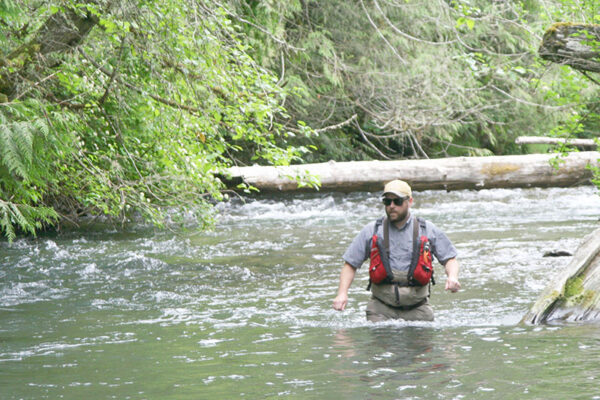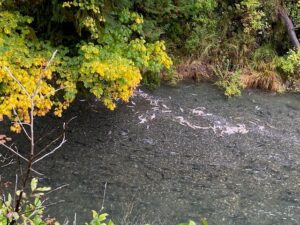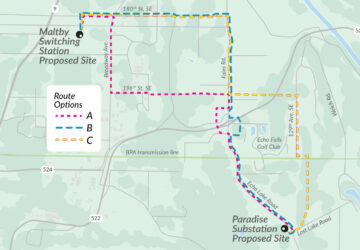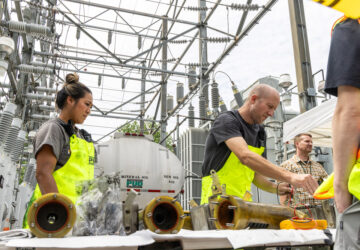
Pink Salmon Forecast Shows Skyrocketing Numbers
< All Stories
In odd-numbered years, pink salmon, or humpies as they’re colloquially known, return to the Puget Sound and their spawning grounds in the many rivers that cut through the region. On the Sultan River, and many other local rivers, Snohomish PUD’s fish biologists can set their watch to it.
But in recent years, those numbers of returning pinks have exploded, threatening a fragile ecosystem and possibly having a detrimental effect on Chinook salmon and Southern Resident killer whale (SRKW) populations.
This connection was recently made in a new study led by salmon scientist, Gregory T. Ruggerone, with Natural Resources Consultants, Inc., and three fish biologists with ties to the PUD, including Natural Resources Manager Andrew McDonnell and Keith Binkley and Larry Lowe, two recently retired members of the PUD’s Natural Resources group.

Using the Sultan River and PUD fish count data as a basis, the study investigated the potential link of increasing pink salmon numbers and the decline in abundance and productivity of Puget Sound Chinook salmon and SRKWs on biennial patterns (e.g. even year vs odd year).
Since 1997, pink salmon have reached record-high abundances in the north Pacific Ocean and Puget Sound. The study found that this surge in adult pink salmon returning to Puget Sound during odd years corresponded with a marked decline in returning adult Chinook salmon and influenced birth and death rates of SRKW populations.
But why? One of the reasons is overcrowding. The data gathered by PUD staff on the Sultan River found that Chinook salmon abundance was on average 34% lower in odd-numbered years compared to even, a pattern not observed prior to 1997 and the increased presence of pink salmon.
The theory is that as more pink salmon returned to spawn in the Sultan River in odd-numbered years, Chinook salmon shift their spawning locations further upstream to avoid them. This shift led to reduced reproductive success for Chinook.
“Even with all of the work we’ve done on the Sultan to add and improve habitat, the pinks are just simply overcrowding Chinook pushing them upstream into more scour prone habitats. This can negatively impact incubating eggs in the gravel, reducing the number of juvenile Chinook that are produced in the Sultan River during odd years,” said Andrew. “There’s only so much real estate on the river, and pinks dominate much of that during odd years, which makes it tough for Chinook.”
The downstream effect of lower Chinook numbers is also impacting the endangered SRKWs, whose population in the Salish Sea declined 25% from 1995 to 2022. The researchers found that SRKW’s higher mortality and lower birth rates in even years can be attributed to the lagged effect of lower Chinook numbers during odd years – the primary food source for SRKWs.
“SRKW’s prefer to prey on Chinook and will basically skip over dozens of pinks in search of a single Chinook salmon,” said Andrew. “The Southern Residents are very picky eaters.”
The issue is simple: the pinks are so abundant that it is making it difficult for SRKWs to use their echolocation to find yummy Chinook. As SRKWs use echolocation to scan the waters of the Puget Sound, the large numbers of pinks are interfering with SRKWs foraging abilities.
The prevalence of pinks has even started to impact rivers and fish habitat as far away as Norway. In 2017, rivers along the Norwegian coast exploded with numbers of nonnative, Pacific pink salmon, with more than 11,000 either caught or observed in 272 rivers. This has altered migration and distribution of spawning Atlantic salmon.
Greg, Andrew and the PUD’s Natural Resources staff were scheduled to take a delegation of Norwegian scientists and dignitaries on a tour of the Sultan River and surrounding area in late April to share their findings and targeted management to make improvements. Unfortunately, due to sickness the delegation had to cancel.
These biennial surges in pink salmon and the compelling evidence of their resulting impacts to Chinook and SRKW populations won’t be fixed overnight. The researchers do recommend controlling pink salmon through various methods of live harvest techniques to reduce numbers of pinks making it to the spawning grounds and reducing hatchery production of pink salmon as mitigation measures that can be taken now. Overall, it will take an ecosystem-wide approach to address the issue.
“For the PUD, we will continue to work with our local salmon recovery partners here in Puget Sound and remain focused on targeted actions on the Sultan that give fish a great place to call home during their short time in the freshwater environment,” said Andrew.
Pinkies Up!
The 2025 Puget Sound pink salmon forecast is 7.76 million — up 70% from the 10-year cycle average — and predicted to be the third largest total return on record (up from a 2023 forecast of 3.95 million and an actual return of 7.22 million). The Green and Nisqually rivers are expected to have strong pink returns. In southern British Columbia, the Fraser River pink forecast is 27 million.
Check out Pink Returns in August
Pink salmon return to the Sultan River in late August and peak around mid-September. A great opportunity to view salmon spawning in the Sultan River is via the city of Sultan’s Osprey Park trail network and restored side channel habitats created by the PUD related to the relicensing of the Jackson Hydro Project in 2012. In 2025, the PUD created an additional 2,000 lineal feet of side channel habitat that was grant funded as part of ongoing environmental stewardship efforts.









